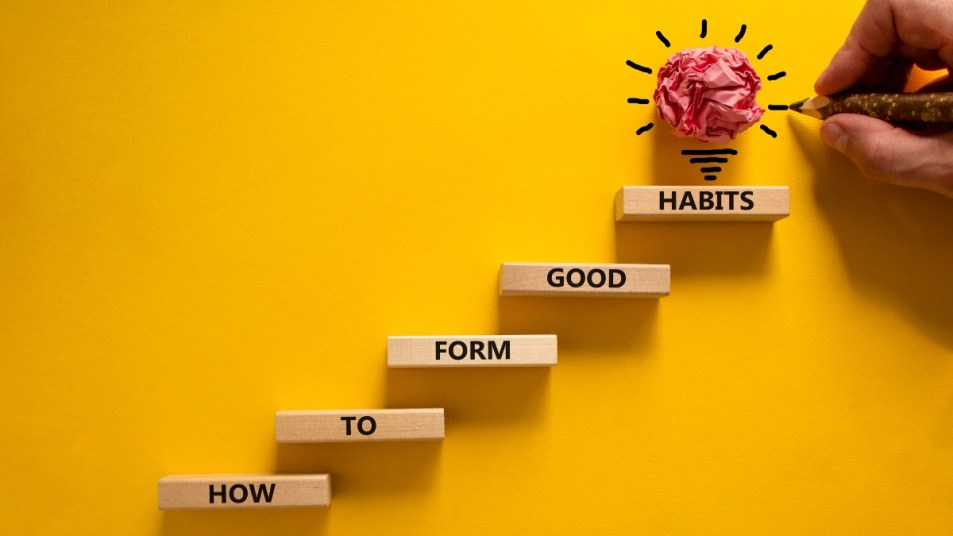What Is Habit Pairing and Stacking? Answer: The Way To Make Your 2023 Goals Stick
The key is to start small, and that will help you stay consistent.

There’s a trait many of us share: We like to procrastinate the start of healthy habits and hold off on pursuing new goals until the “right” time. I do it myself on a small scale: I set a timer at 4 p.m. to pay a bill, for example. But if I miss 4 p.m., I set the timer for 5 p.m. instead of paying the bill immediately. More recently, I did this on a bigger scale: I set a goal to exercise every day, starting on January 1. And then, the right time came and went, and I didn’t start.
Why does this pattern leave me feeling so disappointed? If I can’t even start, I think, I’ll never finish. Here’s the secret I have to keep telling myself: There’s never going to be a right time. Or rather, any time is the right time! If you’re like me, and feel like you missed out on sticking to your New Year’s resolution already, you can start right now. To stay consistent, there are two tricks you ought to try: habit pairing and habit stacking. Keep reading to learn more.
What is habit pairing?
I recently came across the concept of habit pairing on social media, and it’s completely changed the way I think about my to-do list. The idea behind habit pairing is to do something you enjoy while completing a task you don’t enjoy. For example, I started listening to an audiobook while doing the dishes. This change might seem small and inconsequential, but it’s put a seemingly negative chore in a positive light for me. Dishwashing has turned into a peaceful, neutral task that keeps me occupied while I listen to a book.
Here are a few other examples of habit pairing you can incorporate into your daily (or weekly) routine:
- Enjoy catching up with a loved one every week on the phone? Instead of sitting down to take the call, get up and go for a walk. Talking while walking will boost your weekly step count without you even realizing it.
- Waiting for your food to heat up in the microwave? Instead of sitting down, do a set of squats, calf raises, or push-ups against the counter while you wait.
- Craving a chocolate chip cookie? Don’t ignore your craving — instead, pair it with something that will help keep you satiated, like a scoop of vanilla Greek yogurt.
What is habit stacking?
A slightly different approach, habit stacking is a trick that piggy-backs new habits onto old ones. For example: Every morning, you brush your teeth. This habit is so ingrained in your schedule that you don’t even think about it — so, it’s the perfect habit to stack. How do you do this? Add a small habit, like a five-minute stretch, immediately after brushing your teeth. Your morning routine will now look like this: Brush teeth, stretch for five minutes. (Tip: Don’t even leave the bathroom to stretch. Do it all in the same room, so you begin to associate clean teeth with stretching.) Before long, that five-minute stretch will become ingrained in your schedule, too.
Why is habit stacking so effective? Psychologist Melissa Ming Foynes, PhD, told RealSimple.com that the brain likes to capitalize on a neural pathways that already exist. In other words, the brain is lazy — it loves to re-work old neural connections, and make those stronger, instead of creating new pathways. As a result, new habits become a lot less overwhelming. Here are a few other examples of habit stacking to try and add to your routine:
- When I put on my socks, I will stretch my legs for 20 seconds.
- After washing my face in the morning, I will wipe down the sink.
- When I make my morning cup of coffee, I will pour myself a glass of water and drink them side by side.
- After every shower, I will spritz the shower curtain with a cleaning spray.
Once you are comfortable with routine habits, you can also apply habit stacks to less-regular occurrences:
- If I buy a new piece of clothing and take it home, I will take an old item out of my closet and donate it.
- Anytime I want to buy something over $100, I will wait 24 hours before doing so.
- Whenever I’m in a Zoom meeting, I will stand up instead of sitting down.
I’ve found that starting small is the key to making habit stacks stick. Tiny switches, like drinking a glass of water with my morning coffee, feel easy and manageable. And the more I stick to those small habits, the easier it is to start bigger healthy habits. The best part: There is naturally less room in my schedule for bad habits, like doomscrolling.
What small habits are you going to try, and what’s worked for you?












